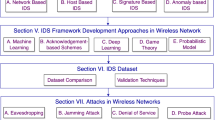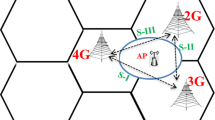Abstract
Stations in IEEE 802.11 ad-hoc WLAN protocol exchange frames by contending for the channel and follow the binary exponential backoff for retransmitting the frames on collisions. This contention and collisions lead to low throughput and high power consumption. Although the stations can enter sleep mode, however they are forced to keep awake for full Beacon interval period if there are frames buffered for them. This long awake period leads to high power consumption. We have devised improved mechanisms that facilitate transmissions with reduced contention. We have defined a reservation period in which the senders reserve the channel by announcing the data frames to be transmitted to the Power Save (PS) stations. These announced frames are then transmitted collision-free in the following transmission period, leading to high throughput. The PS stations keep awake for short duration to receive these frames at predetermined periods, leading to high power saving. The mechanisms involve only software changes to the existing 802.11 protocol and can be implemented on the existing 802.11 WLAN cards. The average power consumption in our mechanisms is only 1/6th of the power consumed in the 802.11b protocol, with the stations consuming 84% lesser power. Our maximum throughput improved to 25% higher than the throughput of the 802.11b protocol. Our work also shows significant performance improvement over some related work in this area. Under conditions of optimal throughput, our improved protocol consumes 55% to 70% lesser power than SPAN protocol and has 3 to 5.8 times better Throughput/Energy consumption characteristics than DPSM protocol.
Similar content being viewed by others
References
V.K. Khanna, “Improving the performance of IEEE 802.11 wireless LAN protocol,” NCC 2001.
IEEE 802.11, 1999 Edition, Wireless LAN MAC and Physical Layer Specifications.
C. Chiasserini and R.R. Rao, “Improving battery performance by using traffic shaping techniques,” IEEE Journal on Selected Areas in Communications 19(7) (2001) 1385–1394.
L.M. Feeney and M. Nilsson, “Investigating the energy consumption of a wireless network interface in an ad hoc networking environment,” in: IEEE INFOCOM (2001) pp. 1548–1557.
Y. Du, C. Herrmann, K. May, S. Hulyalkar, B. Manor and D. Evans, “Wireless ATM LAN with and without infrastructure,” in: IEEE Communications (Apr. 1998) pp. 90–95.
H. Woesner, J. Ebert, M. Schlager and A. Wolisz, “Power–saving mechanisms in emerging standards for WLANs: MAC level perspective,” IEEE Personal Commonications (June 1998) 40–48.
P. Littieri and M.B. Srivastava, “Advances in wireless terminals,” IEEE Personal Communications (Feb. 1999) 6–19.
C. Fullmer and J. Garcia-Luna-Aceves, “Solution to hidden terminal problems in wireless networks,” in: ACM SIGCOMM (Sept. 1997).
J.P. Monks, V. Bharghavan and W.W. Hwu, “A power controlled multiple access protocol for wireless packet networks,” in: IEEE INFOCOM (2001).
IEEE 802.11b-1999, Supplement to 802.11: Higher speed PHY extension in 2.4 GHz band.
J. Lorch and A.J. Smith, “Software strategies for portable computer energy management,” IEEE Personal Communications 5(3) (1998) 60–73.
J. Chen, K. Sivalingam, P. Agrawal and S. Kishore, “Comparison of MAC protocols for wireless networks based on battery power consumption,” in: IEEE INFOCOM (1998) pp. 150–157.
B. Chen, K. Jamieson, H. Balakrishnan and R. Morris, “SPAN: An energy-efficient coordination algorithm for topology maintenance in ad hoc wireless networks,” ACM Wireless Networks Journal 8(5) (2002) 481–494.
E.-S. Jung and N.H. Vaidya, “An energy efficient MAC protocol for wireless LANs” in: IEEE INFOCOM (2002) pp. 1756–1764.
A. Kamerman and L. Montaban, “WaveLAN–II: A high performance wireless LAN for the unlicensed band,” Bell Labs Technical Journal, 2(3) (1997).
X. Wang and D.P. Agrawal, “Analysis and optimization of energy efficiency in 802.11 distributed doordination function,” in: IEEE International Conference on Performance, Computing, and Communications (2004) pp. 707–712.
L. Jia, X. Liu, G. Noubir and R. Rajaraman, “Transmission power control for ad hoc wireless networks: throughput, energy and fairness,” in: IEEE Wireless Communications and Networking Conference (2005) Vol. 1, pp. 619–625.
C. Wang and W. Tang, “A probability-based algorithm to adjust contention window in IEEE 802.11 DCF,” in: International Conference on Communications, Circuits and Systems, Vol. 1, (2004) pp. 418–422.
C. Wang, B. Li and L. Li, “A new collision resolution mechanism to enhance the performance of 802.11 DCF,” IEEE Transactions on Vehicular Technology 53(4) (2004) 1235–1246.
C. Papachristou and F.N. Pavlidou, “Collision-free operation in ad hoc carrier sense multiple access networks,” IEEE Communications Letters 6(8) (2002) 352–354.
S. Yan, Y. Zhuo and S. Wu, “An adaptive RTS threshold adjust algorithm based on minimum energy consumption in IEEE 802.11 DCF,” in: International Conference on Communication Technology Proceedings (2003) Vol. 2, pp. 1210–1214.
D. Gu and J. Zhang, “QoS Enhancement in IEEE 802.11 Wireless Local Area Networks,” in: IEEE Communications (June 2003) pp. 120–124.
Author information
Authors and Affiliations
Corresponding author
Additional information
Vimal K. Khanna (vimal_k@ieee.org) has nearly 21 years experience in the Communications Software industry. He has conducted research to develop innovative networking protocols and products in a range of domains, like TCP/IP suite, Dynamic Source Routing, IEEE 802.11 WLAN, ATM, Frame Relay, ISO/OSI protocols suite, SNMP, Ethernet, X.25/PAD, etc. His independently written papers have appeared in leading international archival networking journals. He has also developed innovative high performance techniques in the Operating Systems domain. His work on performance enhancements to Unix/Linux STREAMS kernel mechanisms has won wide acceptance in the industry and is cited on the Linux STREAMS (LiS) Open Source Community Website. He is on the Technical Editorial Board of “IEEE Communications” magazine (pub. New York) since 1999. He has acted as a reviewer for “IEEE Multimedia” magazine and multiple IEEE international conferences, like Globecom, ICC, etc. He has been an All India rank holder in the Indian Engineering Services Examinations and Silver Medallist in the All India Senior Secondary School Examinations (Class XII). He has been recipient of Ministry of Education All India Merit Scholarship and the National Talent Search Scholarship.
Hari M. Gupta received the B.E. degree from the University of Roorkee, now the Indian Institute of Technology (IIT), Roorkee, in 1967, the M.Tech. degree from IIT, Kharagpur in 1969, and the Ph.D. degree from IIT Kanpur in 1974. He joined the faculty of Department of Electrical Engineering at IIT, Delhi in 1973 where he has been a professor since 1986. He has been the Dean of Undergraduate Studies, the Head of the Department of Electrical Engineering, and the Coordinator of Bharti School of Telecommunication Technology and Management at IIT, Delhi. He has held faculty appointments at McGill University, Montreal, Canada and Drexel University, Philadelphia, PA, USA. He has been an academic visitor to University of Maryland, College Park, MD, USA, the Media Lab, at Massachusetts Institute of Technology, Cambridge, MA, USA, the Swiss Federal Institute of Technology, Lausanne, Switzerland, Helsinki University of Technology, Helsinki, Finland, and several British Universities. His academic and professional interests are in communication systems, computer communication networks, multimedia systems and photonic information systems. Dr. Gupta has been India’s representative on the International Federation for Information processing (IFIP) Communications Committee. He is a Fellow of The Institution of Electronics and Telecommunication Engineers (IETE), The Institution of Engineers (India), and a Senior Member of Computer Society of India (CSI). He has been the Vice-President of the Systems Society of India, a Council Member of IETE, the Chairman of the Data Communication Division of CSI, and a Founder Member of the Association for Security of Information Systems (ASIS).
Satyavardhan Maheshwari was born in Indore, India. He received M.S. degree from the Department of Electrical Engineering, IIT Delhi in 2003. He received B.E degree from the Department of Electrical Engineering, Devi Ahilya University, Indore. He joined Reliance Infocomm, India in 2003 as an R&D Engineer working on CDMA2000 system design. He is working on CDMA Base Station and planning in RF Engineering. His research area is IEEE 802.11 Ad-hoc Networks.
Rights and permissions
About this article
Cite this article
Khanna, V.K., Gupta, H.M. & Maheshwari, S. A high throughput and low power ad-hoc wireless LAN protocol. Wireless Netw 14, 1–16 (2008). https://doi.org/10.1007/s11276-006-7350-3
Published:
Issue Date:
DOI: https://doi.org/10.1007/s11276-006-7350-3




